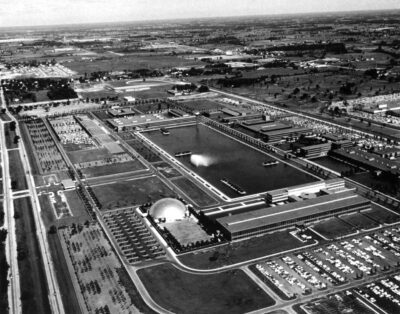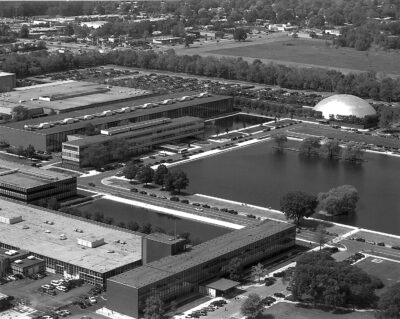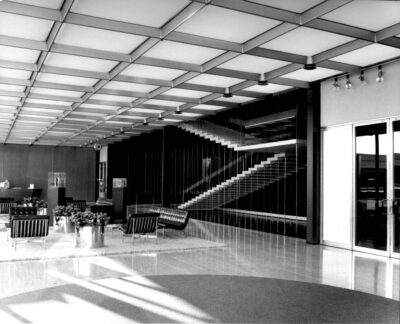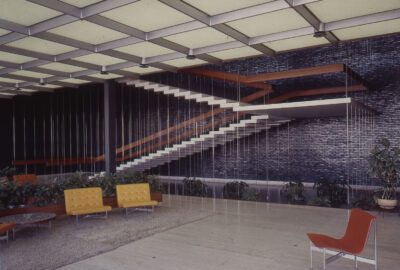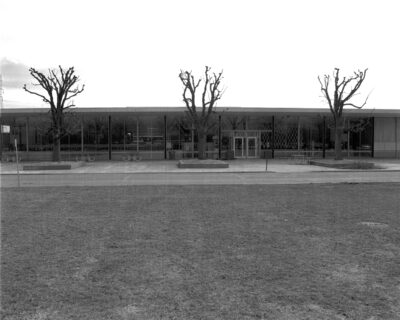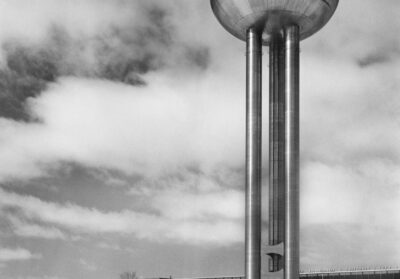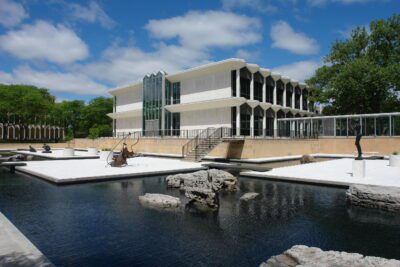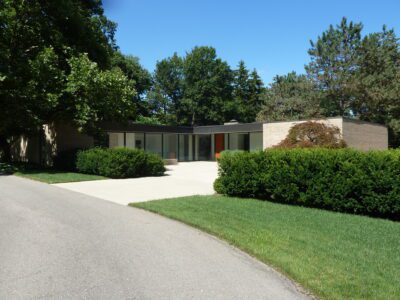People: Florence Knoll , Kevin Roche , Smith, Hinchman & Grylls , Peter Petkoff , Eero Saarinen , ,
Date: 1953-1955
City: Warren
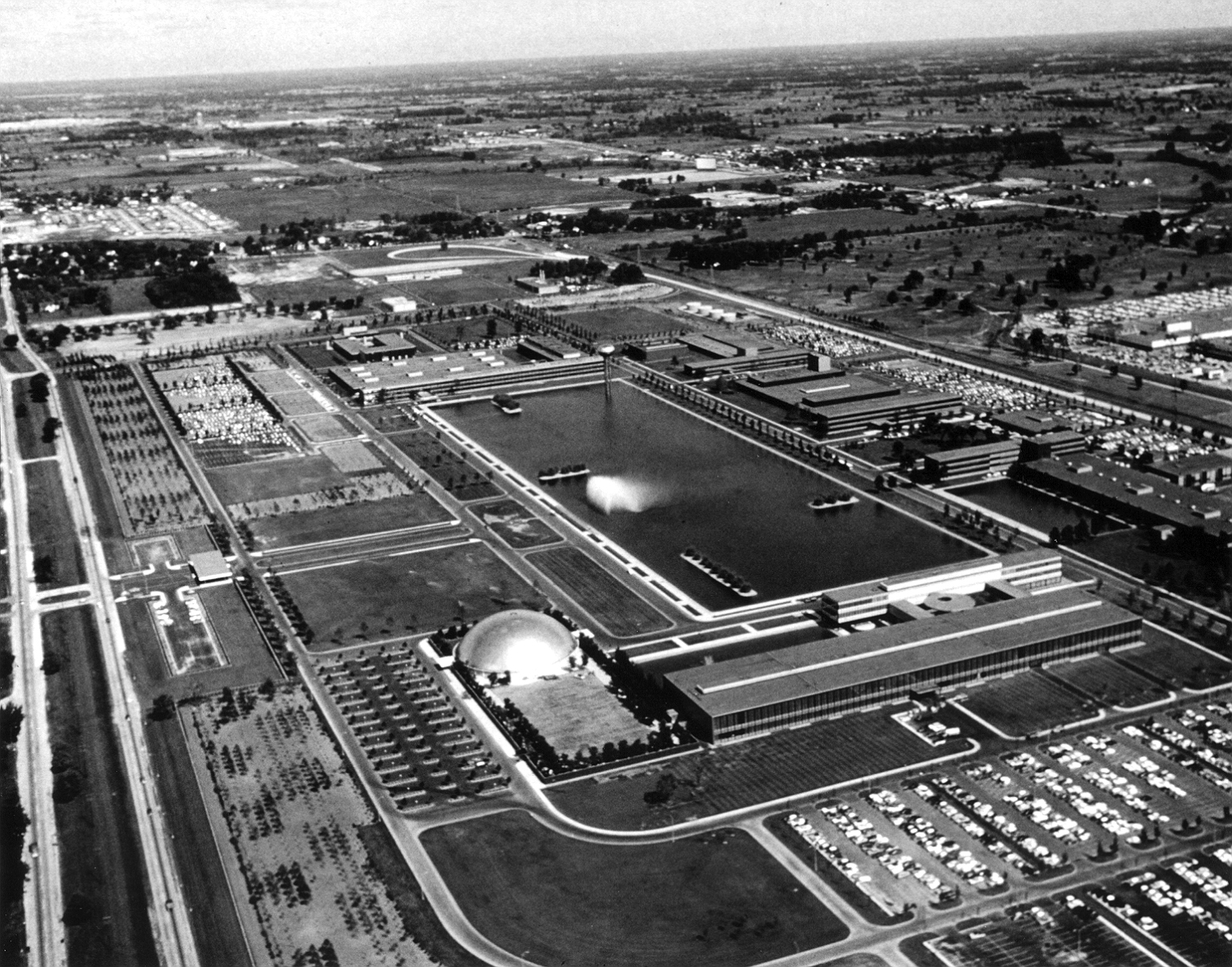
The General Motors Technical Center is nationally significant as one of the most important works of architect Eero Saarinen (1910-1961). The Technical Center represents several key aspects of this renowned architect’s career. The first of these is that the Technical Center marks his emergence onto the international stage as an important designer independent of his work with his father Eliel, first bringing him to wide national attention and acclaim. The Technical Center project was embraced around the world as the embodiment of the spirit of the post-World War II age in America and of the prosperity and modernity of the nation and its people. The second of these is that this campus represents Saarinen’s work not just as a creator of buildings, but as the planner/designer of total environments. At the Technical Center, Saarinen worked with and orchestrated key collaborators on the campus’s buildings and their material details, construction methods, landscape, furniture and furnishings, and artwork, creating a design totality unparalleled in the period that established a key working method for the architect. Finally, the Technical Center is also significant as the first of four influential Saarinen suburban corporate campuses (along with later projects for IBM, Bell Laboratories, and John Deere), that set the design standard for this important post-World War II landscape and architectural type that represented a sea change in American business facilities.
While the Technical Center is also associated with a number of other nationally significant individuals, including automobile and industrial designer Harley Earl and General Motors executives Alfred P. Sloan and Charles F. Kettering, the Technical Center illustrates neither the areas of significance of these individuals nor, more importantly, the period in which the nationally significant achievements of these men were made. Further, while the nationally significant landscape architect Thomas Church was involved in the design of the Technical Center, it cannot be considered to be a signature design by Church. In contrast to the domestic projects for which Church is most widely known and recognized, and on which he himself wrote influentially for a large American audience, Church contributed aspects of the landscape to the Technical Center, but was not the design leader for it. The project is undoubtedly characterized by a degree of technical and artistic collaboration, but under the principal design aegis and direction of Eero Saarinen.
Architectural historian Alice Friedman has noted in her recent American Glamor and the Evolution of Modern Architecture that, in his career cut short by his sudden death from a brain tumor in 1961, Eero Saarinen achieved an astounding amount of national success in his practice. As she further remarks, this success rested on a series of “corporate headquarters and campus-like research centers for many of the household names of American industry and manufacturing” as well as “plum government jobs.” Friedman accurately notes that these projects “put a very public stamp of approval on Saarinen’s distinctive approach to architecture, handing him the lion’s share of responsibility for creating a new American style for the postwar age.”[1] In contrast to other architects revered by their peers but relatively unknown to the American public, Saarinen’s acclaim reached a broad audience through these projects. This acclaim was established by the General Motors Technical Center, which marked the point when Saarinen’s career diverged from his collaboration with his father Eliel Saarinen. Eero had been leading certain design projects within the firm of Saarinen, Swanson and Saarinen before the Technical Center, and had been engaged in such important independent endeavors as his experiments in chair, structure, and house design with Charles Eames of the late 1930s and early 1940s, but his practice remained essentially subsidiary to Eliel’s until the father’s death in 1950. The Technical Center project allowed Eero’s practice not merely to survive his father’s death, but also to grow significantly beyond it, establishing a highly public, separate, independent identity. This identity was one that was recognized much more broadly than Eliel’s own substantial professional reputation, beginning with, and thanks to the Technical Center project, along with the Jefferson Memorial project, which was begun at the same time.
As a number of authors have noted, Saarinen’s collaborative approach with his clients was a key to the success of his projects with them: as Friedman puts it – “communicating the identity and meaning of the individual project,” by taking his cues from the corporate culture and identity of his clients.[2] This collaborative method and tendency to vary his approach to style to express the nature of the project and the client, as opposed to the autocratic imposition of form in a project, was one that would later lead to mixed critical reception for Saarinen, although the reception of the Technical Center itself was almost universally laudatory. As his widow Aline remarked after the architect had died, “the critics punished him often.” The architect Robert Venturi, who worked in the Saarinen office during the Technical Center project, encapsulated one key aspect of the objections to his methods in a critique of the firm soon after he left it, saying that Saarinen “did not have a singular approach,” which Venturi took “as a sign of weakness.”[3] Saarinen’s approach to clients such as GM was seen as pandering by some: for example, Manfredo Tafuri, the noted Italian architect, historian, theoretician and critic, derided Saarinen’s approach as “corporate advertising” and the influential historian, author, and Yale University professor Vincent Scully was at best lukewarm about Saarinen’s approach, believing that Louis I. Kahn and Robert Venturi “offered a much better way toward a reasonable future for architecture” than Saarinen’s more eclectic strategy did. [4] Despite this divided critical response to Saarinen’s corporate work in his lifetime, the architect’s collaborative and expressive method unquestionably made the architect one of, if not the most important designer in the American public imagination in the period: he was the architect who both captured and enormously influenced the post-war culture. The Technical Center was the project that created Saarinen’s broad American stature and working method, and was deeply rooted in GM’s own culture. In essence, it made Saarinen famous. It also caused his office to grow from a small staff to one of forty people, many of whom, including Gunnar Birkerts, Kevin Roche, John Dinkeloo, Cesar Pelli, Anthony Lumsden, Joseph Lacy, J. Henderson Barr, Olav Hammerström, and Venturi, went on to have extremely important careers as modernists. The Technical Center established Eero’s identity as an independent, world class designer in his own right. It thus took his career beyond its early phase of its association with his father – in which Eero always stood to a certain extent in Eliel’s shadow – to a nationally significant career ended prematurely in 1961.
[1] Alice Friedman, American Glamor and the Evolution of Modern Architecture (New Haven: Yale University Press, 2010), 109.
[2] Friedman, American Glamor, 112.
[3] Jayne Merkel, Eero Saarinen (New York: Phaidon Press, 2005), 75.
[4] On the mixed critical response to Saarinen’s work, see Friedman, American Glamor, 112-14, and Vincent Scully, “Rethinking Saarinen,” in Eero Saarinen: Shaping the Future, Eeva-Liisa Pelkonen and Donald Albrecht, eds. (New Haven: Yale University Press), 13-14.
Text excerpted from the General Motors Technical Center National Historic Landmark Nomination.

